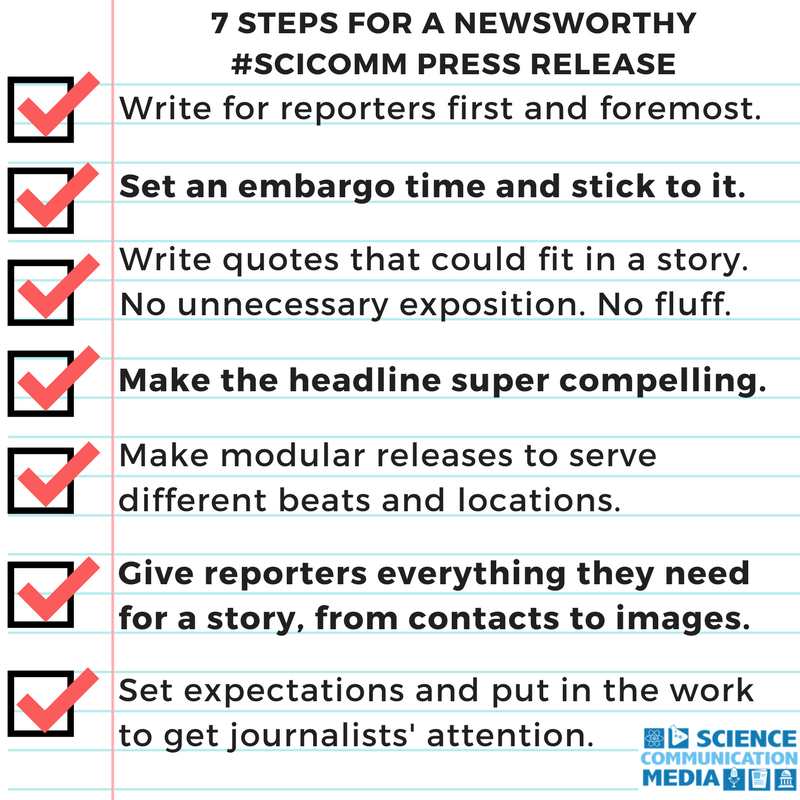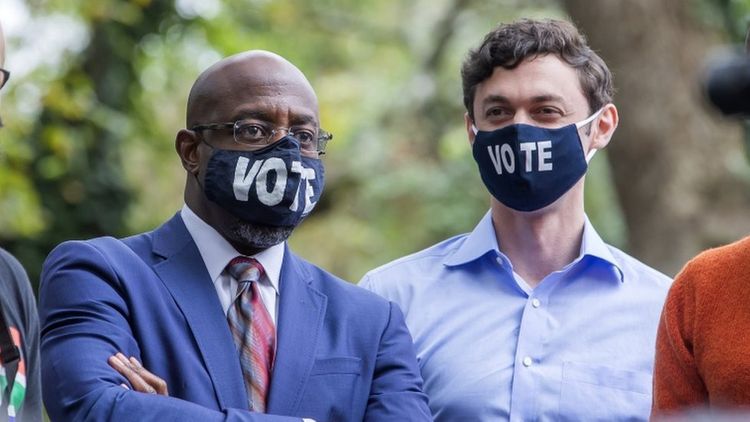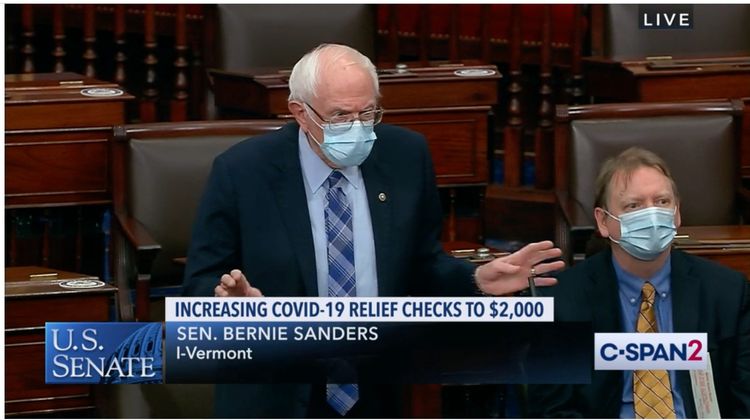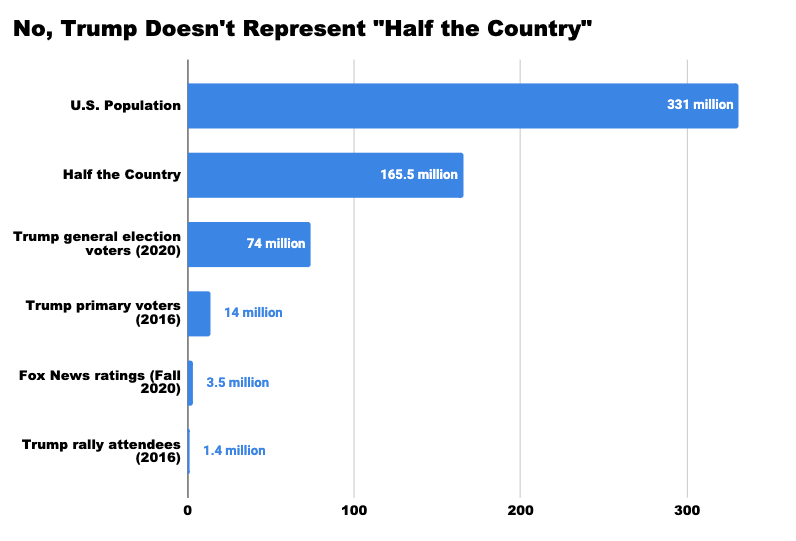Seven Guidelines for Making a Newsworthy Science Press Release


Every once in a while, someone in media or communications will declare the press release is dead. But the truth is that it just keeps evolving. And if you need to send information to a whole bunch of journalists at once…well, you need to write a press release. Understanding what goes into a good science press release is critical not just for scientists who have to write one on their own, but also for scientists who need to make sure they’re on the same page as their institutional communication staffers.
So here are seven guidelines to keep in mind when writing a release. BUT first — make sure you have your main messages done. Those need to get reflected in a release as well as any other communication you’re doing.
We should also define our terms before we dive in because I often hear the terms “press release” and “statement” used interchangeably, but they are definitely two different things. A press release is about something new and is written like a news story. A “statement” is a reaction to something else happening in the news and includes a quote from a credible source. In many ways, the purpose of a press release is to advertise a possible story to a journalist. By contrast, the purpose of a statement is to give a journalist a quote they can drop into a story they are already writing.
Okay, let’s get into it!

1. Press releases are for the press, not other audiences.
It feels odd to have to say this, but press releases should be written for journalists first and foremost. Too often, I see releases loaded up with attempts to market a university, sell a product, or propagate some political spin. Journalists don’t want that kind of fluff. They need hard news, facts and figures, and quotes that help put research in context for their audience. Using a press release as a conduit for other types of communication is a recipe for having reporters ignore the message. Further, doing so dilutes journalists’ impression of a source as relevant and useful, making them less likely to respond to future releases.
So the main thing I ask when editing a press release is this: Does it help a journalist do their job? If not, it probably doesn’t belong in the release.
Of course, we often face institutional pressure to include a lot of extra information in press releases. People want to toot their own horns, promote their pet projects and put in more and more information. A good press officer will push back, reminding everyone that a press release’s main audience is journalists. Additionally, we have plenty of other outlets where we can post things that aren’t immediately relevant for journalists, including blogs and social media accounts.
2. Embargoed releases make it easier for journalists to cover new research.
If you can wait to promote your research, offering an embargoed copy of a press release and the research itself to a targeted list of reporters is the best way to go. An “embargo” simply means that the reporters agree not to publish until a set time and date, usually a few days in the future. It gives them time to plan on coverage, dig into the research, interview scientists, and, importantly, pitch editors on a story. Usually, only a subset of reporters who regularly cover a topic get an embargoed copy. And note that an embargo is not an “exclusive.” That latter term means that one and only one outlet gets the story.
The alternative — blasting something out “for immediate release” — can wind up hitting reporters’ inboxes while they’re working on something else and usually results in less coverage or no coverage at all.
Do reporters break embargoes? Very rarely, in my experience. And if they do…well, that means someone covered your story, so it’s not a totally bad thing! If anyone ever breaks an embargo — intentionally or not — you can ask them to take a story down, but you probably won’t have much luck. Instead, you’ll have to alert everyone else who has the story that the embargo has been “lifted.”
When to lift an embargo? Earlier in the day is almost always better, especially since so many news outlets produce morning newsletters. A 6AM embargo is common and some organizations even say 12AM as a way of saying, “really, any old time in the morning is fine by us.” And, of course, don’t break your own embargo by publishing the research on your site before stories hit.
3. Quotes should be quotable, meaning they can be inserted directly into news stories.
Don’t use quotes for expository purposes. Use them to say something about why the research matters, what was interesting about how it was done, or what scientists recommend in response to their research, e.g. personal recommendations for the reader of an eventual news story, policy recommendations, or avenues for future research.
For examples, here’s an unnecessary, expository quote: “The eclipse will last for about two minutes and forty seconds and will cover more than 88 percent of the sun locally.”
These are objective facts that can be conveyed on their own and attributed to a source without them reflecting someone’s perspective.
Now here’s an example of a quote a reporter would find more useful: “If you stay home, you’re still going to see a really amazing astronomical event, but the total eclipse is worth the trip.”
It helps answer an obvious question a journalist would ask: “So…is it worth it to drive to where people can see the totality?” And it’s the type of quote a local TV or radio reporter would want to use to help their audience figure out their plans for eclipse viewing.
Institutions should also be wary of loading up a release with quotes. If too many spokespeople try to get involved in a release, it can quickly turn into a wall of text and disembodied voices that just isn’t very useful for journalists. If other people want to be on call to help answer inquiries, great, but adding too many additional voices to a release just makes it harder for journalists to sift through it and find the information they need. And in a lot of cases, journalists are only going to quote one person from an organization, anyway.
Finally, reporters are almost never going to use fluff quotes in which one speaker thanks someone else for funding or their hard work or partnerships. Unless the contribution someone made is truly newsworthy to someone outside an institution, save those quotes for a blog post or social media.
4. Subject lines and headlines need to grab the reader.
Journalists’ inboxes and newsfeeds are full of press releases. What gets a journalist to open an email? A subject line and headline that feels timely, interesting and relevant to their beat. (And, although this should go without saying, the research has to actually back up the headline!)
So a good headline for a study might be: “New study finds NYC subways could face more Sandy-like flooding.”
It’s new! It’s local. It gives the reader the most striking finding right away. Heck yeah, they’re opening that. Doubly so if they’re a local reporter in New York City. A TV or radio reporter who doesn’t cover science stories often might even pick up on that given local interest in the subway system.
A less compelling headline would be: “Researchers find coastal flooding growing more extreme.” This is more generic and doesn’t tell the reader anything unique about the research. Importantly, it’s missing what’s new! A beat reporter who covers science and coastal regions might be interested, but the TV or radio reporter is not going to notice it.
Of course, a big study about coastal flooding might have lots of compelling findings for different locations, which brings me to my next point…
5. Make modular releases.
It’s more work, but modular releases can really pay off. If a scientific study has findings related to all 50 states, it can be worth doing 50 versions of a release, or at least version for where findings are of possible significant interest. Similarly, changing up releases based on beat can be useful. A press release about a medical device might be of interest to a policy beat reporter, a consumer reporter and a business reporter. They’ll each be looking for a different angle and might even benefit from different headlines, different lead paragraph, and different lead quotes.
Of course, that all takes more time. And there’s no way around it, good media relations work is definitely time consuming.
6. Give reporters everything they need to do a story.
Press releases should have email addresses, phone numbers and relevant handles for a press officer and / or lead researcher, not just a generic contact. Importantly, releases should have a link to where the press release lives or will live online — this is critical for making news easy to share on social media, especially for journalists who may be interested, but can’t do a whole story.
Press releases should end with “boilerplate,” giving journalists additional information about a researcher, lab, or institution, including relevant links to sites and social accounts that may be useful to their work.
The news is also increasingly visual. If there are any relevant images, charts or even videos from a study, it’s good to put them online and link to them in a release. Even if there aren’t visuals to draw from, consider generating an image with a few key takeaways about the research that’s sized for Facebook and Twitter. Journalists can share those images while appending their own commentary and reporting.
7. Set your expectations and put in the work necessary to achieve them.
Journalists are understandably weary of PR people sending them irrelevant press releases and myriad follow ups. Over the years, I’ve seen the efficacy of blasting out press releases to big lists of journalists plummet. Strong results come from newsworthy, targeted pitches that are based on understanding a reporter’s beat, their outlet’s audience and their interest in a given topic. And that, of course, requires time and people power. The bottom line is that the more widely a researcher or organization wants to get coverage, the more work they need to put into making that happen.
Originally published at Science Communication Media.




